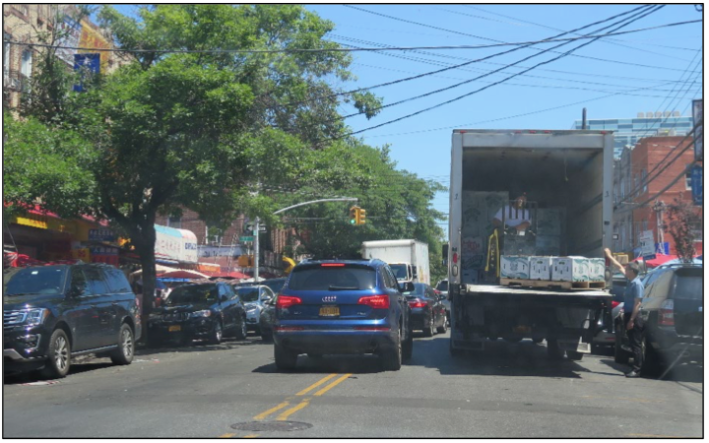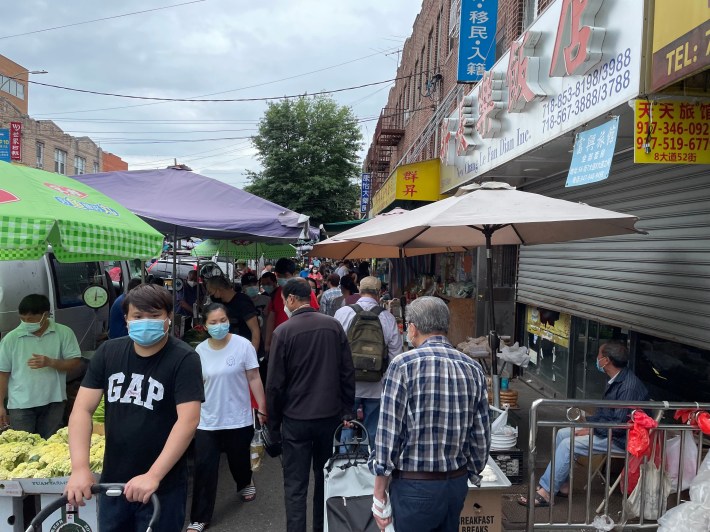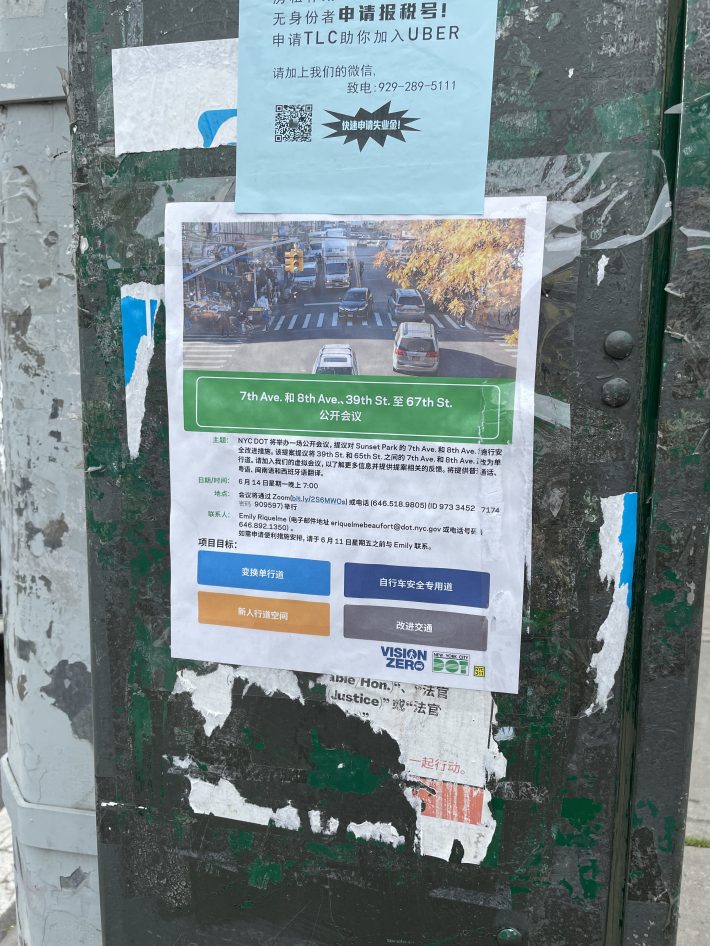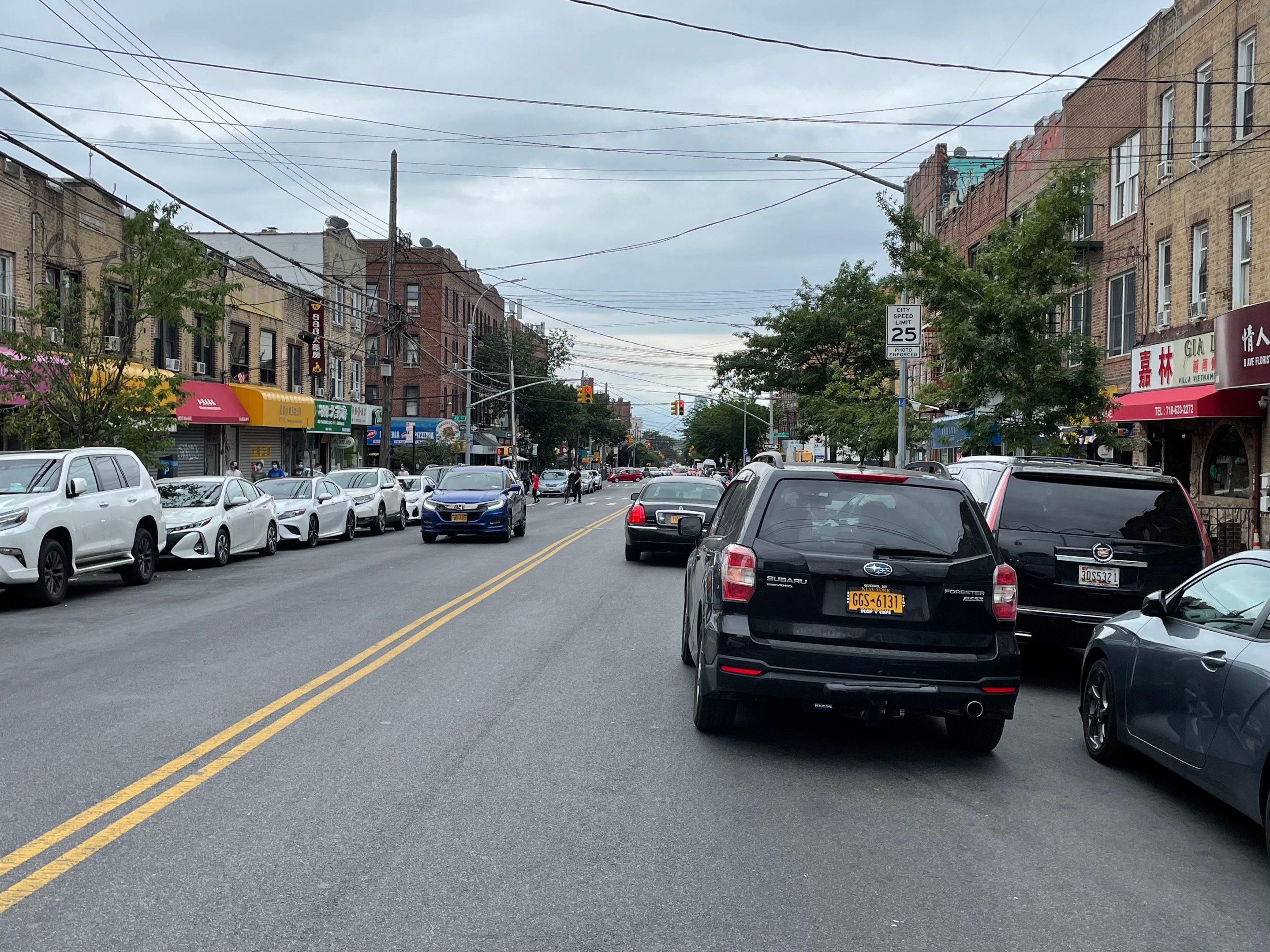There are two ways this one-way plan can go.
The Department of Transportation wants to remake a pair of Brooklyn streets from traffic-choked, dangerous two-way commercial corridors into one-way streets to make the roadways safer and boost business — but one neighborhood group is already showing its support is for the convenience of car drivers, not the safety of neighborhood residents.
The plan is an ambitious makeover of busy (and dangerous) Seventh and Eighth avenues between 39th and 65th streets in Sunset Park, both currently two-way roadways. Seventh Avenue would become a southbound one-way street and Eighth Avenue would be turned into a northbound one-way street — and both roadways would get protected bike lanes.
The plan [PDF] also calls for more commercial loading zones, and, perhaps most significantly, an expanded sidewalk on the west side of Eighth Avenue between 51st and 60th streets — a major show of support for the neighborhood's long-suffering pedestrians.

The radical reimagining of the street is in response to chaotic road and sidewalk conditions that led the DOT to deem Eighth Avenue a Vision Zero priority corridor in 2019. Eighth Avenue, a thriving commercial district in the heart of Brooklyn's Chinatown, has contributed to 17 severe injuries to pedestrians and 15 severe injuries to motorists between 2014 and 2018 according to DOT data. City crash data compiled by CrashMapper also shows that danger of the current layout, as 163 people (30 cyclists, 72 pedestrians and 61 motorists) were injured and two pedestrian killed in 732 crashes since January, 2019 in the zone being considered for the redesign. That's almost one crash per day.
This isn't the first time the DOT has attempted to fiddle with traffic patterns on Seventh Avenue in Brooklyn. In 2007, the agency proposed changing Seventh Avenue between Flatbush and Prospect avenues into a southbound one-way street and Sixth Avenue between Atlantic Avenue and 23rd Street into a northbound one-way street. The plan was assailed by street safety adovcaes because it did not do anything but focus on moving cars around rather than making all road users safer (though one prominent writer of the day at least asked Park Slopers to try to understand the agency's thinking at the time).
The new plan proposes reducing the dominance of the automobile on each block, which won it praise from local street safety activists.
"The plan itself looks great [because] one-way conversions really help reduce conflicts among pedestrians, people who drive and who bike," said Transportation Alternatives Brooklyn Organizer Dulcie Canton.
The DOT suggested that its study of the streets discovered that the two-way traffic directions, combined with bus routes and double parking from both shoppers and businesses getting deliveries, created unpredictable traffic patterns. That, in turn, led to a frequent failure-to-yield injuries for cyclists when drivers made right turns, pedestrian injuries as drivers had to pull around double-parked cars and trucks and higher than average rates of head-on collisions between drivers. The agency typically attempts to narrow Wild West streets to reduce speeding, but the DOT said that its analysis showed that speeding was not the main reason for the high number of injuries. So another approach was needed.
As with any street redesign that seeks a more cyclist- and pedestrian-friendly layout than simply four lanes for the movement and storage of cars and trucks, the DOT said some parking spots — all told, about 183 between 39th and 67th streets — will be reclaimed for safety. That leaves roughly 90 percent of the parking spots untouched, and the local council member thinks that's a small price to pay.
"Instead of people thinking, 'Oh, it's a one-way street now and there's less parking,' people are now beginning to see the value of more pedestrian space, and that more sidewalk area means opportunities for some sanitation relief," said Council Member Carlos Menchaca, who represents most of the project area.
Knowing the parking conversation will be a contentious piece of a process that involves upending the entire road, Menchaca said he's pitching the parking removing as a good solution to a broken status quo.
"You can't do anything without removing parking, period," he said. "And so the way that I address that is head-on with people. If it's a resident, I say, 'You live here, you can walk to the store and we want to make it more friendly for you to walk and get your stuff.' And for everybody else, I spend a lot of time saying, 'The current situation doesn't work, right? All this that we're pointing to, it doesn't work. And to change that, we need to take some parking.' It's not a lot, and really it could be more."
For the agency to successfully sell its plan, it will most likely have to make the case to potential opposition that more sidewalk space could mean more comfortable customers and more foot traffic from prospective shoppers. More than the bike lane, the DOT's biggest swing may wind up being the proposal for a widened sidewalk on the southern stretch of Eighth Avenue. The nine blocks where the expanded sidewalk is being proposed is full of seafood shops, fruit stands and home goods stores whose wares spill out onto the sidewalk, which isn't out of the ordinary on commercial districts in the city.
What separates the stretch from similar commercial corridors is that the existing sidewalk has Manhattan-level pedestrian congestion (a DOT observation found over 5,000 pedestrians in a single hour passing 57th Street and Eighth Avenue) with no infrastructure to absorb it.

Census data shows that almost two-thirds of households in Sunset Park don't have a car. But some activists say that Eighth Avenue is a commercial destination, so the decision to remove some parking is more complicated than it seems.
"The extension of the sidewalk will take away parking and impact how folks will be able to get in and out," Ting Ting Fu, an organizer with environmental justice organization UPROSE told Streetsblog last week. "The Chinese community was hit really hard with COVID, and so we're worried about how this will affect businesses. Eighth Avenue is the mega-center for everything you want. Even people living in Bensonhurst or smaller pockets in Brooklyn, they go to Eighth Avenue to buy their Chinese medicine, they go to buy their blankets, to buy fish, it's all on that strip. And if folks can't park, then they won't be able to access the products from their country."
The DOT said it conducted 400 on-street surveys in the neighborhood in February in collaboration with Brooklyn Chinese-American Association, Chinese-American Planning Council and the Sunset Park Recreation Center. The agency said those surveys found 88 percent of people got to the area on foot or using public transportation, and that 43 percent of respondents said they felt unsafe using the packed sidewalks.
In addition, 78 percent of survey respondents said that they though the sidewalks were "always too crowded," a number that stands out.
The agency also highlighted business outreach that was done at 340 areas stores over three days in 2019 when 60 percent of business owners told DOT they were having difficulty with deliveries because of a lack of dedicated curb space.

But Fu questioned the quality of the outreach effort.
"You're reaching out to Chinese businesses, where they've been really hit hard by COVID and have experienced racial violence against them," she said. "And the Chinese community is already iffy about people approaching them, so asking them to join a meeting through Zoom [might not be effective]. A lot of the businesses owners don't have time to talk the moment that you come in. And so did the DOT circle back to them for their input? How meaningful was the DOT engagement for business owners residents on Eighth Avenue?" (DOT said it conducted a small business meeting this March, too.)

The current outreach process also includes a public meeting scheduled for June 14, followed by a second community advisory board meeting in June and then a joint presentation to Community Boards 7, 10 and 12. Fu said UPROSE is asking for a total pause on the plan in order to get more input, but Menchaca said he's willing to see how the three scheduled meetings go before he weighs in on whether enough community input has guided the plan. The key for the DOT, the Council member said, is to effectively show the neighborhood tribunals how trading a small number of parking spaces can benefit even skeptics of the plan.
"Every time we we get out there, we move closer to a good plan, a good compromise and a safer street," he said. "The thing that the DOT has to avoid is sometimes they'll just stop working on something and say they can't go forward because they say people hate it. You kind of have to walk people through this thing, that's organizing 101, this is not rocket science. When someone says, 'I don't like something,' it doesn't mean that you should scrap it. You just need to understand the different pieces, because they'll like parts of it, and if they like parts of it, then their self-interest was understood and responded to."
The outreach meeting will take place on Monday, June 14 at 7 p.m. on Zoom (access by clicking here). Meeting ID: 973 3452 7174 and Passcode: 909597.
Note: Fu left the organization after speaking to Streetsblog. Attempts to get answers to Streetsblog’s follow up questions were unanswered.






